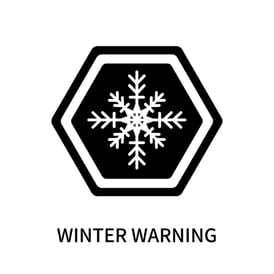Winter can be an extremely challenging time of year. For much of the country, the season means cold, bleak, and bouts of rain, ice, or snow. Given these environmental factors, winter can be very dangerous.
 With a serious risk for injuries and attacks on an individual’s immune system, it’s important to prepare to avoid the woes of winter. Here four of the most common winter woes and tips to beat them.
With a serious risk for injuries and attacks on an individual’s immune system, it’s important to prepare to avoid the woes of winter. Here four of the most common winter woes and tips to beat them.
-
Cold & Flu
Cold and flu season runs from approximately November through April. Winter forces more people indoors which can rapidly increase the chance of exposure to outside contaminants both at the workplace and at home.
A few simple yet effective strategies for preventing the flu include:
- Getting a flu vaccination
- Frequently and effective washing of the hands (minimum of 20 seconds with soap and water)
- Sanitizing any shared office supplies regularly
- Avoiding or keeping your distance from ill individuals
- Staying properly hydrated
- Maintaining a healthy diet
- Exercising consistently
- Getting outside to enjoy the fresh air as much as possible
If you start to experience flu-like symptoms, slow yourself down and provide your body with the correct environment to recover back to full strength. Taking the time to rest early after the onset of symptoms will decrease the length of time that you experience the cold or flu.
-
Cold Injuries & How to Deal
There are three forms of cold injuries: frostnip, frostbite, and hypothermia.
Frostnip is the least severe of all cold-related injuries but still needs to be taken seriously. This occurs in response to exposure to cold weather and typically affects the face, ears, toes, and fingers.
Symptoms include:
- Pale appearance
- Burning, itching, pain, tingling, and numbness of the affected area
Warming the tissues should resolve these symptoms as there is no permanent damage. Preventative measures include covering up with gloves, scarves as well as wearing thick wool socks when outside in the elements.
Frostbite is the more severe version of frostnip that occurs in response to prolonged exposure to cold weather. In this injury, the tissue is no longer simply cold, pale, and feeling burning or tingling, but the skin and underlying tissue are freezing.
Symptoms include:
- Frostnip symptoms
- Blisters
- Firm feeling skin
- Loss of sensation
- Changes in skin color and sensation, first red and cold, followed by numbness and hard, pale, yellow, blue, or gray skin
Frostbite requires rapid rewarming of the tissue and medical attention because prolonged exposure can lead to permanent skin damage. Preventative measures are like frostnip which include wearing the proper attire for the weather but also include limiting the amount of time spent out in the elements.
Hypothermia is the final and most severe cold weather injury. This develops when the core body temperature falls drops from about 98.6 degrees to below 95 degrees. This occurs when an individual’s body loses heat faster than they can create it.
Symptoms include:
- Include confusion
- Memory loss
- Drowsiness, exhaustion
- Slurred speech
Suspected individuals with this condition should be treated immediately.
-
Slip/Trip/Fall Prevention
In most areas, winter usually brings with it snow, ice, and rain which makes many surfaces treacherous to navigate and increases the risk of falls. Injuries from slips and trips may include fractures, sprains, strains, head injuries, and more.
Take these precautions when walking on uneven and slippery services to reduce the risk of injury:
- Avoid walking on snowy, icy, or slippery surfaces, when possible
- Take short steps and walk slowly
- Utilize three points of contact like a railing or another stable structure
- Avoid carrying loads
- Test for slick areas by tapping your foot on them before stepping onto it
-
Carbon Monoxide Poisoning
To stay warm during the winter, we burn fuel to operate our furnaces, fireplaces, and other external heating agents. Carbon monoxide is a byproduct emitted by the burning of these fuels. It is completely colorless and odorless in nature which makes dangerous virtually impossible to detect without assistance. Sources of this deadly poison include vehicles, small engines, stoves, fireplaces, gas ranges, and furnaces.
Symptoms of carbon monoxide poisoning include:
- dizziness
- headache
- nausea
- fatigue
- vomiting
- difficulty breathing
- chest pain
Although these seem like common complaints, if you suspect you may have been exposed to carbon monoxide, medical attention should be sought out immediately.
The best way to combat exposure to this deadly gas is to prevent it from happening in the first place. The most effective way to limit carbon monoxide exposure is to regularly maintain your appliances as well as installing and properly maintaining carbon monoxide detectors.
Staying safe during the winter months can take a bit of effort but with a little preparation, you can avoid the hazards of the season.